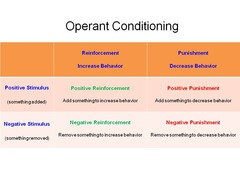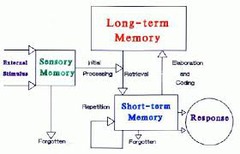
Avoidance Learning
Iconic (Visual)2. Echoic (Auditory)
Explicit


Avoidance Learning
Iconic (Visual)2. Echoic (Auditory)
Explicit

associative learninglearning that certain events occur together. The events may be two…
learninglong lasting change in behavior resulting from experienceclassical conditioning-PAVLOV-learning by associationUSURCSCRunconditioned stimulusunconditioned…
What is the definition of learning?Relatively permanent modification through experienceWhat are the…
What are some things people can do to maximize or improve their…
learning?process in which changes in behaviour arise as a result of experiences…
associative learninglearning that certain events occur together. The events may be two…
observational learningLearning by observing others.modelPerson observed in observational learning.modelingProcess of observing and…
Discrimination – DefinitionOrganisms learn to make a response in the presence of…
MemoryThe persistence of learning over time through the storage and retrieval of…
learninga relatively permanent change in an organisms behavior due to experiencehabituationdecreasing responsiveness…
Cognitive view of learningA general approach that views learning as an active…
learningchange in an organism’s behavior or thought as ar esult of experience(learning)…

Hi! We can edit and customize this paper for you. Just send your request for getting no plagiarism essay
Order here